One of the exercises in chess classes for young players is to play chess without looking at the board.
A common trait of world number four Hikaru Nakamura (Elo 2,778) is that whenever he needs to make complex calculations, he often looks up or to the sides, without paying attention to the chessboard. This helps him better imagine the next variations of the chess position. Of course, the Japanese-American can play chess "blindly", that is, without looking at the board the entire time, at a level not much lower than his Elo.
In 2016, Nakamura played online blitz and superblitz blindfold against International Master (IM) Danny Rensch (2,402) blindfold. He won every game, even winning by checkmate. Nakamura had only three minutes for blitz or one minute for superblitz each game. He could not see any pieces on the screen, only knew his opponent's moves through symbols. He also moved his pieces based on those symbols.
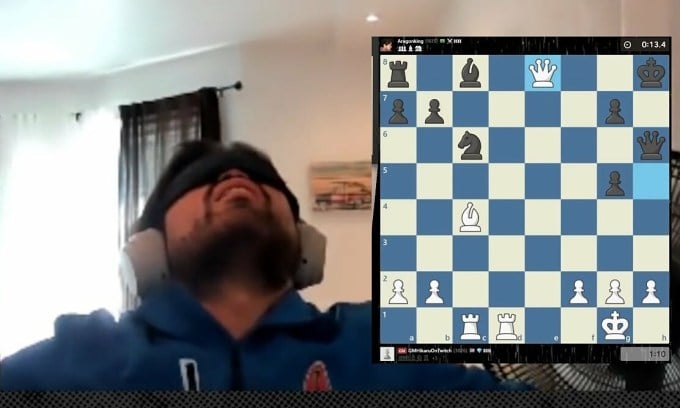
Hikaru Nakamura in an online blind chess game in 2023. Photo: screenshot
The 8x8 square chess board consists of 64 squares, the vertical rows are numbered from 1 to 8, and the horizontal rows are labeled a to h. Therefore, each square will have its own position, for example, the square in the lower left corner is a1, the upper right corner is h8. Initially, each side has 16 chess pieces, each type of piece also has its own symbol, according to international standards, the king is K, the queen is Q, the rook is R, the bishop is B, the knight is N and the pawn does not need a symbol. For example, the knight move from square g1 to square f3 was previously symbolized as Ng1-f3, later simplified to Nf3. The pawn move from e2 to e4 is symbolized as e4.
Thanks to these symbols, players can play chess blindly, if a third person helps them move their pieces through the above symbols. That was the case of world number one Magnus Carlsen (2,829), when he just won against world U8 champion Marc Llari (2,017) in an exhibition match in Paris on October 31. Carlsen was blindfolded and had his arms crossed, but still won against Llari, in less than 40 moves.
Blind chess players can also move their own pieces, as when world number two Fabiano Caruana (2,795) played an exhibition match with streamer sisters Alexandra Botez (1,977) and Andrea Botez (1,709) on August 9. Caruana was blindfolded, moved his pieces based on his perception of the squares, and still beat the two sisters in a five-minute match.
Based on the Elo of the players mentioned above, the experts like Carlsen, Nakamura or Caruana are not much different when blindfolded than when they have their eyes open. At this level, looking at the board or not does not significantly affect the quality of the moves.
Most players, even amateurs, can play blind chess if they practice . A Danish player, Martin Justesen, with an Elo of 1,824, once surveyed players on their ability to clearly imagine chess positions from the following symbols (1. e4 e5 2. Nf3 Nc6 3. Bb5 d6 4. Nc3 Ne7 5. Nd5 g6), on a scale of 1 to 5 points. Players with an Elo of around 1,200 had an average perception of around 2.5 points, while players with an Elo of 2,200 or higher had an perception of around 4 points. This is understandable because the more players play, the higher their level, the better they will imagine chess positions.
However, Justesen believes that practicing blind chess is also effective. The first condition is that the player needs to know how to play chess, then they have to spend a little time every day, after a month, they will be able to play a game blind. So an Elo 1,200 player, that is, who knows the basic moves and openings, can also play blind chess by practicing.
When players start learning chess systematically, blind chess is already a familiar exercise for them. They can turn their faces away and ask a third person to move their pieces. They can even practice without a board or pieces, just by saying the signs of each move to each other. Therefore, players can practice anywhere without any equipment, making chess one of the least expensive sports .
It's also a practice method for masters, including Carlsen. "I started playing blind chess with my dad, when we went skiing or climbing mountains," the five-time world champion told Chess24 in 2015. "It's a way for players to train their minds, and a lot of chess practice takes this form."
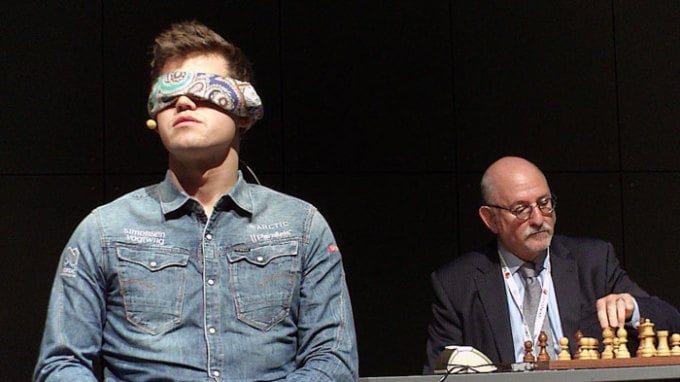
Magnus Carlsen in a blind chess exhibition in Vienna, Austria in 2015. Photo: Chess24
The key to getting better at blind chess lies in the ability to memorize the position in your head . When playing blind chess, Nakamura says he only plans two or three moves ahead against weaker opponents. Against more skilled opponents, he plans five or six moves ahead. Calculating deeper variables depends on the player's memory, and Nakamura admits he is not a genius.
Nakamura once took an IQ test and scored 102, within the normal range. “I wish I could call myself a math genius, but that’s too far-fetched,” he says.
Most players at the grandmaster level (around Elo 2,000-2,200) and above can play blindfolded, with a little practice. How much better they are blindfolded will depend on how far they can calculate. Under normal conditions, players can calculate about 10 moves ahead, or more. But not everyone can do that blindfolded.
The 14th world champion Vladimir Kramnik is considered the king of blind chess. From 1992 to 2011, an annual Amber chess tournament was held in Monaco, inviting top players to participate, including the blind chess category. Kramnik holds the record of nine titles in this category, while the next players have a maximum of four titles.
Blind chess proficiency is also reflected in the number of simultaneous blindfolded games, with the record of 48 games belonging to 35-year-old Grandmaster Timur Gareyev (2,570) in 2017. Nakamura said that he once played blindfolded chess with 15 players at the same time, while Carlsen also played blindfolded chess with 10 players. If more practice in this genre, masters like Carlsen or Nakamura could break Gareyev's record.
Kramnik once said, perhaps jokingly, that he would like to play blindfolded in regular chess, at the 2009 Amber tournament. But for such masters, blindfolding or not does not affect the results much against opponents of a much lower level.
Xuan Binh
Source link




![[Photo] Keep your warehouse safe in all situations](https://vphoto.vietnam.vn/thumb/1200x675/vietnam/resource/IMAGE/2025/10/1/3eb4eceafe68497989865e7faa4e4d0e)

![[Photo] President of the Cuban National Assembly visits President Ho Chi Minh's Mausoleum](https://vphoto.vietnam.vn/thumb/1200x675/vietnam/resource/IMAGE/2025/10/1/39f1142310fc4dae9e3de4fcc9ac2ed0)
![[Photo] Hanoi morning of October 1: Prolonged flooding, people wade to work](https://vphoto.vietnam.vn/thumb/1200x675/vietnam/resource/IMAGE/2025/10/1/189be28938e3493fa26b2938efa2059e)



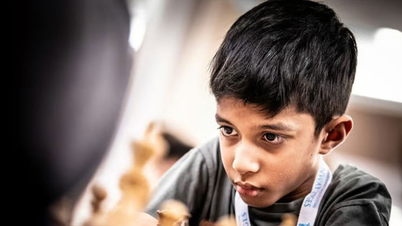
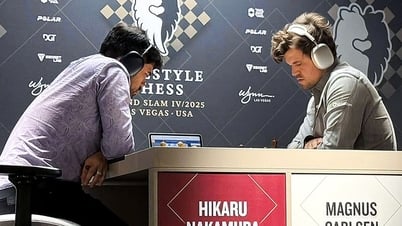
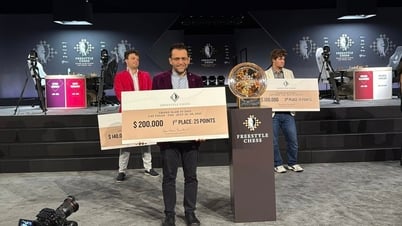
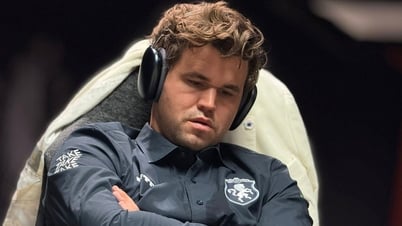
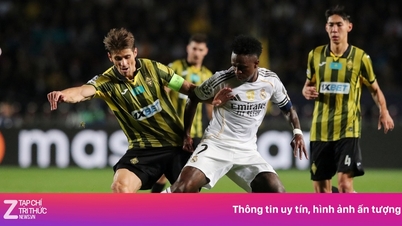






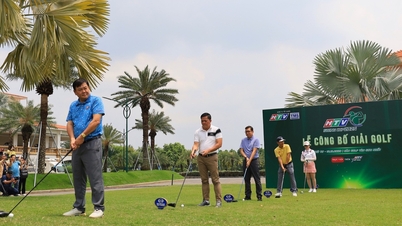
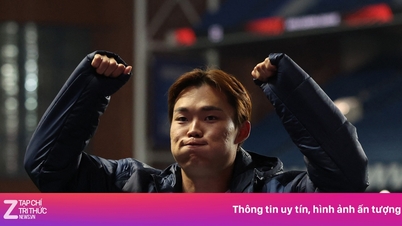







































































Comment (0)